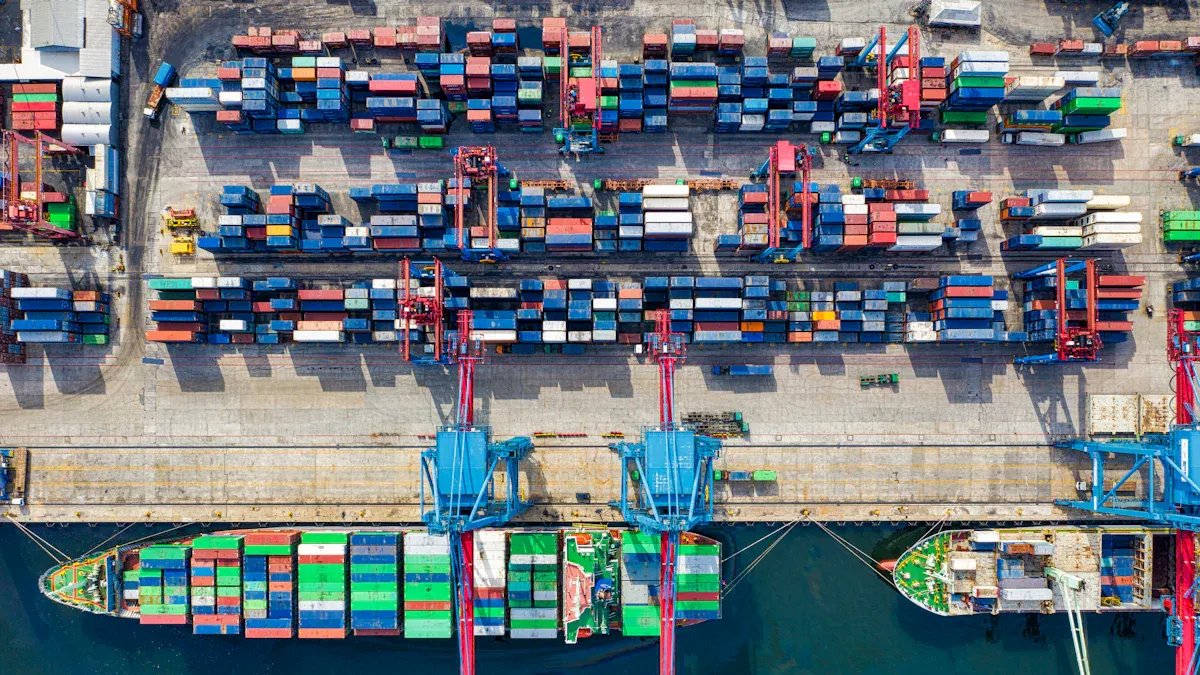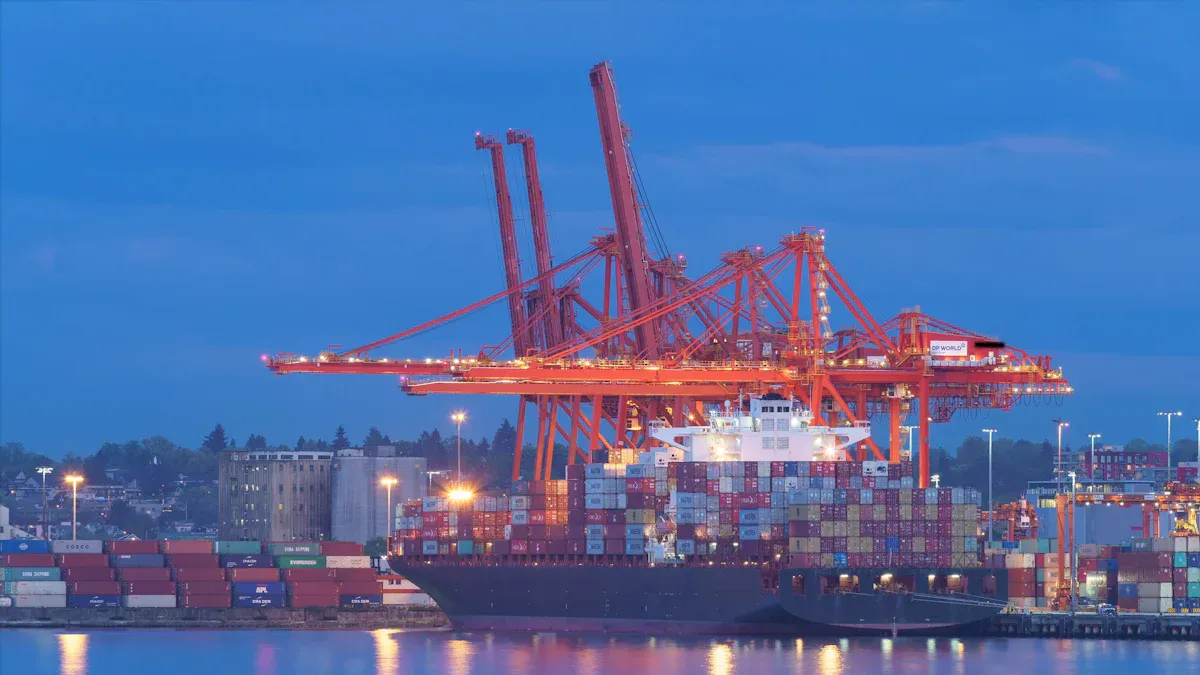How Traditional International Freight Forwarders Achieve Strategic Breakthroughs through Digital Transformation

Traditional freight forwarding faces mounting challenges in today’s rapidly changing logistics landscape. Customers demand greater visibility, faster delivery, and lower costs, but manual processes and fragmented systems often fall short. Digital transformation offers a solution by introducing real-time tracking, streamlined operations, and data-driven insights. These tools improve customer satisfaction and operational efficiency while fostering innovation through partnerships with technology providers. This raises an important question: How can you embrace digital transformation to stay competitive and thrive in a shifting market?
Key Takeaways
Digital tools make work easier by automating tasks and organizing workflows. This lets teams focus on more important jobs.
Live tracking makes customers happy by giving accurate shipping updates. It builds trust and reduces worries.
Using cloud systems connects different logistics tools. This improves tracking and helps respond quickly to changes.
Data analysis helps freight companies make smart choices, save money, and use resources better.
Encouraging new ideas helps companies improve and meet customer needs. This keeps them ahead in the market.
Digital Tools and Technologies Transforming Freight Forwarding

Automation and Process Optimization
Automation is revolutionizing freight forwarding by streamlining repetitive tasks and reducing human error. By implementing automated systems, you can optimize workflows, improve efficiency, and cut operational costs. For instance, Maersk’s TradeLens platform uses blockchain technology to simplify shipping processes, enhancing transparency and efficiency. Similarly, DHL employs AI algorithms to optimize logistics flows, resulting in faster deliveries and lower costs.
Automation also enables better resource management. A large distribution center, for example, reduced its average order processing time by 15% and achieved higher throughput through effective shift management. Additionally, identifying vehicle-specific inefficiencies led to annual fuel cost savings of 10%. These improvements demonstrate how automation can transform your operations and boost profitability.
Case Study | Description | Key Outcomes |
|---|---|---|
Maersk’s TradeLens Platform | Utilizes blockchain to streamline shipping information across partners. | Enhanced transparency and efficiency in logistics operations. |
DHL’s AI Algorithms | Employs AI to optimize logistics flows. | Improved delivery times and reduced operational costs. |
Automation doesn’t just save time; it also reduces errors. Lean Six Sigma and Robotic Process Automation (RPA) integration in various industries has shown significant reductions in process time and operational costs. For example, manufacturing companies have reported productivity increases of up to 35% within the first year of implementation. By adopting these technologies, you can achieve similar results in freight forwarding.
Real-Time Tracking and Visibility
Real-time tracking is a game-changer in freight forwarding. It provides you with up-to-the-minute information about shipment locations, enabling better decision-making and improved customer satisfaction. Metrics like the perfect order index and on-time delivery rates highlight the benefits of enhanced visibility. For example, a higher perfect order index reflects shipments delivered on time without damage or errors, boosting customer trust.
Metric | Description |
|---|---|
Perfect order index | Percentage of shipments delivered on time, with no problems or damage. |
On-time deliveries | Rate at which shipments reach their destinations within the agreed timeframe. |
Inventory turnover ratio | Frequency of stock sales within a given period. |
Order accuracy | Percentage of orders delivered without errors, such as wrong addresses. |
Real-time tracking also helps you identify bottlenecks in the supply chain. By monitoring shipment status and inventory levels, you can address delays proactively and ensure smooth operations. This level of visibility not only enhances operational efficiency but also strengthens your reputation as a reliable logistics provider.
Data Analytics and Predictive Insights
Data analytics and predictive insights empower you to make informed, data-driven decisions in freight forwarding. By analyzing logistics data, you can identify bottlenecks, forecast expenses, and improve resource allocation. For example, advanced analytics can reveal cost-saving opportunities and help you negotiate better supplier rates.
Predictive insights also enable proactive risk management. By identifying potential issues before they escalate, you can minimize disruptions and maintain smooth operations. Additionally, data-driven strategies support sustainable goals, such as reducing carbon emissions and enhancing your company’s reputation.
Visibility across the entire supply chain: Better information gathering helps you identify improvement opportunities.
Better budgeting and forecasting: Data-backed decisions allow you to avoid unforeseen costs.
Continuous improvement through analytics: Ongoing assessment fosters a cycle of development.
Proactive risk management: Predictive analytics mitigate potential issues before they escalate.
By leveraging data analytics, you can also enhance customer experience. Insights into customer preferences enable you to offer personalized services and faster deliveries. Monitoring key performance indicators (KPIs) ensures operational excellence, helping you stay competitive in the evolving logistics landscape.
Strategic Benefits of Digital Transformation for Freight Forwarders

Enhancing Operational Efficiency
Digital transformation empowers you to streamline operations and improve efficiency across the logistics chain. Automation eliminates repetitive tasks, allowing your team to focus on higher-value activities. For example, automated systems can handle order processing, shipment scheduling, and inventory updates with precision. This reduces errors and accelerates workflows. Real-time tracking provides instant updates on shipment locations, enabling you to make quick adjustments and avoid delays. By integrating digital technologies, you can create a seamless supply chain that operates with greater agility and accuracy.
Reducing Costs and Optimizing Resources
Adopting digital solutions helps you cut costs and maximize resource utilization. Automation reduces labor expenses by minimizing manual tasks. Data-driven route optimization lowers fuel consumption and decreases carbon emissions, contributing to sustainability goals. Digitalization enhances efficiency in warehousing, inventory management, transportation, and last-mile delivery. These improvements reduce operational costs while maintaining high service quality. By leveraging data-driven decision making, you can allocate resources more effectively and identify cost-saving opportunities across your logistics network.
Benefits of cost reduction and resource optimization:
Automation minimizes labor costs.
Route optimization reduces fuel expenses and emissions.
Digital tools improve efficiency in all logistics stages.
Achieving Scalability and Market Responsiveness
Scalability and market responsiveness are critical for freight forwarders aiming to thrive in a competitive industry. Digital transformation equips you with the tools to expand operations without compromising efficiency. By adopting scalable technologies, you can handle increased shipment volumes while maintaining high service quality. For instance, cloud-based platforms allow you to manage logistics across multiple regions seamlessly. These systems grow with your business, ensuring you stay prepared for market demands.
Market responsiveness improves when you integrate digital solutions into your operations. Real-time tracking and predictive analytics provide insights that help you adapt to changing customer needs. For example, if demand for a specific route spikes, you can allocate resources quickly to meet the surge. Automation also plays a key role by reducing manual errors and streamlining workflows. This ensures faster response times and better service delivery.
The following table highlights how digital tools enhance scalability and responsiveness:
Scalability also supports long-term growth. Digital tools help you optimize resource allocation, ensuring you can handle peak seasons without overextending your workforce. This agility positions your business as a reliable partner in the logistics industry. By embracing these technologies, you can respond to market shifts effectively and maintain a competitive edge.
Tip: Use predictive analytics to anticipate demand fluctuations and adjust your operations proactively.
Overcoming Challenges in Digital Transformation
Addressing Resistance to Change
Resistance to change remains one of the biggest hurdles in digital transformation. Many freight forwarding companies still rely on paper-based systems and manual processes, with approximately 67% hesitant to adopt digital tools. Employee pushback further complicates the transition, as studies show that 82% of digital transformation efforts fail due to workforce resistance. Financial concerns also play a role, with companies reluctant to invest in upfront costs like software licensing and training programs.
To overcome these barriers, you need to foster a culture of innovation. Start by communicating the benefits of digital adoption clearly to your team. Highlight how automation and real-time tracking can reduce errors and improve efficiency. Offer incentives to encourage employees to embrace new technologies. Additionally, consider implementing pilot programs to demonstrate the effectiveness of digital tools before scaling them across your operations.
Tip: Engage employees early in the transformation process to reduce resistance and build trust.
Bridging Skill Gaps and Training Employees
Skill gaps among employees can slow down digital adoption. Over half of the workforce feels they need more development opportunities, and 94% of employees consider training crucial for retention and satisfaction. Targeted employee development programs can address these gaps effectively. For instance, 90% of HR managers believe training boosts productivity, while 76% of Gen Z learners value learning for career success.
Investing in training programs tailored to your team’s needs will help bridge these gaps. Focus on hands-on workshops and e-learning modules that teach employees how to use new digital tools. Regular feedback sessions can ensure continuous improvement. By prioritizing skill development, you not only enhance operational efficiency but also improve employee morale and retention.

Note: Continuous learning opportunities can transform your workforce into a competitive advantage.
Investing in the Right Technologies
Choosing the right technologies is critical for successful digital transformation. The global freight logistics software market is projected to reach $18.5 billion by 2027, driven by innovations like AI-driven route optimization and blockchain-based customs clearance. These tools enhance operational efficiency, reduce fuel usage, and streamline cross-border logistics.
When selecting technologies, focus on solutions that align with your business goals. AI-powered tools can optimize routes and reduce costs, while predictive analytics improve reliability by anticipating maintenance needs. Smart contracts simplify settlements, saving time and resources. Sustainable practices, such as decarbonization technologies, also help you meet regulatory requirements and improve your market position.
Benefits of adopting advanced technologies:
Smart contracts enable faster settlements.
Predictive analytics enhance reliability and reduce disruptions.
Blockchain accelerates customs clearance processes.
Tip: Prioritize scalable and sustainable technologies to future-proof your operations.
Ensuring Data Security and Compliance
Data security and compliance play a critical role in the success of digital transformation for freight forwarders. As you adopt digital tools, protecting sensitive information becomes essential to maintain trust and meet regulatory requirements. Without robust security measures, your operations could face significant risks, including data breaches and legal penalties.
The transport sector has seen a sharp rise in cyber threats. In 2023, the number of data breaches more than doubled compared to the previous year. This alarming trend underscores the importance of implementing strong data protection strategies. You must prioritize compliance with industry standards like PCI DSS, ISO27001, GDPR, CCPA, and APA. These frameworks ensure that your systems meet global benchmarks for data security and privacy.
Tip: Regularly audit your systems to identify vulnerabilities and ensure compliance with evolving regulations.
Maintaining visibility over your data is equally important. Transparent data management not only helps you meet compliance requirements but also builds customer trust. When clients know their information is secure, they are more likely to choose your services. This trust becomes a cornerstone of your digital transformation journey.
To strengthen your data security, consider adopting advanced technologies. Encryption tools, multi-factor authentication, and blockchain can safeguard sensitive information. Additionally, training your team on cybersecurity best practices ensures that everyone contributes to a secure environment.
By prioritizing data security and compliance, you protect your business from cyber threats and legal challenges. More importantly, you create a foundation of trust and reliability that sets you apart in the competitive freight forwarding industry.
Actionable Steps for Freight Forwarders to Embrace Digital Transformation
Conducting a Digital Readiness Assessment
Before embarking on digital transformation, you need to evaluate your current capabilities. A digital readiness assessment helps you identify strengths, weaknesses, and areas for improvement. This process ensures that your logistics operations align with modern demands. For example, a study of 409 companies in Salzburg and Bavaria revealed that conducting a Digital Readiness Check (DRC) allowed businesses to benchmark their performance. This step is particularly important for freight forwarding companies aiming to optimize supply chain processes.
To conduct an effective assessment, follow these steps:
Analyze your existing workflows and identify inefficiencies.
Evaluate your technology stack to determine gaps in functionality.
Benchmark your performance against industry standards.
Gather feedback from employees and customers to understand pain points.
Tip: Use digital readiness tools to gain a comprehensive view of your organization’s capabilities. This will help you prioritize areas for improvement and allocate resources effectively.
Developing a Comprehensive Digital Strategy
A well-defined digital strategy serves as the foundation for successful transformation. It provides a roadmap for integrating new technologies and achieving your business goals. Start by setting clear objectives. For instance, you might aim to improve operational efficiency, enhance customer satisfaction, or reduce costs. Align these goals with measurable outcomes to track progress effectively.
Your strategy should include the following components:
Technology Selection: Choose solutions that address your specific needs. For example, real-time data tools prevent delays and inefficiencies, while cloud solutions enhance workflow efficiency.
Phased Implementation: Roll out new technologies in stages to minimize disruptions.
Employee Training: Equip your team with the skills needed to use digital tools effectively.
Performance Monitoring: Use KPIs to measure the impact of your initiatives.
Measurable Outcome | Description |
|---|---|
Improved Operational Efficiency | Companies reported a 25% improvement in operational efficiency after reallocating resources. |
Enhanced Decision-Making | Data-driven insights empower leaders to align strategies with organizational goals. |
Improved Customer Experience | 67% of companies saw improved customer retention after addressing inefficiencies. |
Increased Operational Efficiency | Organizations implementing automation reported a 40% reduction in processing times. |
Risk Mitigation | Proactive identification of risks reduces disruptions and ensures business continuity. |
Note: A comprehensive strategy not only guides your transformation but also ensures that all stakeholders remain aligned throughout the process.
Partnering with Technology Providers
Collaborating with technology providers accelerates your digital transformation journey. These partnerships give you access to cutting-edge tools and expertise. For example, FedEx partnered with technology providers to adopt robotics, AI, and blockchain. These innovations improved operational efficiency and customer service. Additionally, implementing Technology Business Management (TBM) enhanced decision-making and collaboration.
Here are some benefits of partnering with technology providers:
Access to advanced solutions like IoT and AI for real-time visibility and proactive decision-making.
Expertise in implementing and managing digital tools tailored to logistics operations.
Support for sustainable practices, such as reducing carbon emissions through optimized routes.
Tip: Choose providers with experience in freight forwarding to ensure their solutions meet your unique needs.
Case Studies of Successful Partnerships:
FedEx leveraged robotics and AI to streamline logistics processes and enhance customer satisfaction.
Blockchain adoption simplified customs clearance, reducing delays and improving transparency.
TBM implementation shifted the focus from cost to business transformation, fostering innovation.
Technology | Benefit |
|---|---|
Real-time Data | Prevents delays, errors, and inefficiencies |
Cloud Solutions | Enhances workflow and operational efficiency |
IoT | Provides real-time visibility |
AI and ML | Enables proactive decision-making |
Big Data Analytics | Identifies market trends and hidden issues |
By partnering with the right providers, you can implement scalable and sustainable solutions that position your business for long-term success.
Why Innovation Matters in Freight Forwarding
Innovation plays a critical role in digital transformation. It allows you to remain relevant and competitive in an industry that evolves rapidly. By leveraging digital tools like artificial intelligence (AI) and big data analytics, you can gain valuable insights into customer preferences and market trends. These insights enable you to create new products and services that disrupt markets and provide a competitive edge.
Key Aspect | Description |
|---|---|
Importance of Innovation | Innovation is crucial for digital transformation, helping businesses remain relevant and competitive. |
Use of Digital Tools | Technologies like AI and big data analytics provide insights into customer preferences and market trends. |
Creation of New Offerings | Insights lead to new products and services that can disrupt markets and create competitive advantages. |
Rapid Prototyping | Digital platforms allow for quick testing of ideas, enabling companies to adapt to market changes. |
For example, rapid prototyping through digital platforms allows you to test ideas quickly and adapt to market changes. This agility ensures that your business stays aligned with customer expectations and industry demands.
Tip: Encourage your team to experiment with new ideas and technologies. Even small innovations can lead to significant improvements in efficiency and customer satisfaction.
Real-World Success: C.H. Robinson’s Approach
C.H. Robinson provides a compelling example of how innovation drives continuous improvement. The company partnered with an electric utility provider to streamline supply chain processes. By aligning improvement initiatives with operational needs, they achieved significant cost savings and enhanced safety. Performance scorecards helped track metrics, ensuring that every improvement aligned with their strategic goals.
Key Takeaways from C.H. Robinson’s Success:
Collaboration fosters innovation and aligns efforts with business objectives.
Performance tracking ensures that improvements deliver measurable results.
Continuous improvement creates long-term value for both the company and its partners.
Steps to Build a Culture of Innovation
Creating a culture of innovation requires deliberate effort and strategic planning. Here are actionable steps to help you foster this mindset within your organization:
Empower Your Team: Encourage employees to share ideas and take ownership of projects. Provide them with the tools and resources needed to experiment and innovate.
Celebrate Success and Learn from Failures: Recognize achievements and use setbacks as learning opportunities. This approach builds confidence and motivates your team to take calculated risks.
Invest in Training and Development: Equip your workforce with the skills needed to leverage digital tools effectively. Training programs ensure that your team stays ahead of technological advancements.
Leverage Technology: Use digital platforms to facilitate collaboration and streamline workflows. Tools like AI and predictive analytics can uncover hidden opportunities and drive smarter decision-making.
Track Progress: Use performance metrics to measure the impact of your initiatives. Regularly review these metrics to identify areas for further improvement.
Note: Building a culture of innovation is not a one-time effort. It requires ongoing commitment and a willingness to adapt to new challenges and opportunities.
The Long-Term Benefits of Continuous Improvement
A culture of continuous improvement ensures that your organization remains agile and resilient. By regularly evaluating processes and seeking ways to enhance them, you can reduce inefficiencies, lower costs, and improve customer satisfaction. This approach also fosters a growth mindset, encouraging your team to embrace change and view challenges as opportunities.
In the freight forwarding industry, where customer expectations and market conditions shift rapidly, continuous improvement becomes a strategic advantage. It positions your business as a forward-thinking leader, capable of delivering innovative solutions that meet the evolving needs of your clients.
Final Thought: By prioritizing innovation and continuous improvement, you can transform your organization into a dynamic, future-ready enterprise. Start today by empowering your team, leveraging technology, and committing to a culture of growth.
Digital transformation has become essential for achieving breakthroughs in freight forwarding. It equips you with tools to streamline operations, enhance customer satisfaction, and stay competitive in the evolving logistics landscape. By adopting modern technologies, you can address challenges and unlock new opportunities for growth.
Take the first step today. Assess your current processes, explore innovative solutions, and embrace change. The future of logistics belongs to those who adapt and lead. Seize this opportunity to transform your business and set a new standard in the industry.
FAQ
What are the biggest challenges in adopting digital transformation?
The main challenges include resistance to change, skill gaps among employees, and high initial investment costs. Overcoming these requires clear communication, targeted training programs, and phased implementation of technologies to minimize disruptions.
How does real-time tracking improve customer satisfaction?
Real-time tracking keeps your customers informed about shipment status. This transparency builds trust and reduces uncertainty. Customers appreciate accurate updates, which enhance their overall experience and strengthen your reputation as a reliable logistics provider.
Why is data security important in digital transformation?
Data security protects sensitive information from breaches and ensures compliance with regulations. Strong security measures, like encryption and multi-factor authentication, safeguard your operations and build customer trust. Without it, your business risks legal penalties and reputational damage.
Tip: Regularly audit your systems to identify vulnerabilities and stay compliant with evolving standards.
See Also
Navigating Tomorrow: Digital Innovations in Logistics Management
Exploring Future Logistics Through Technological Advancements
Transforming Logistics: The Role of Supply Chain Advancements
Artificial Intelligence in Supply Chains: Shaping Future Logistics
